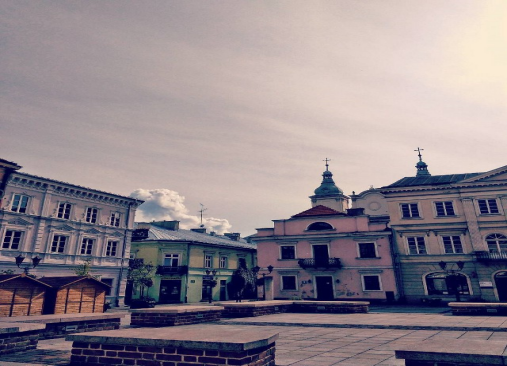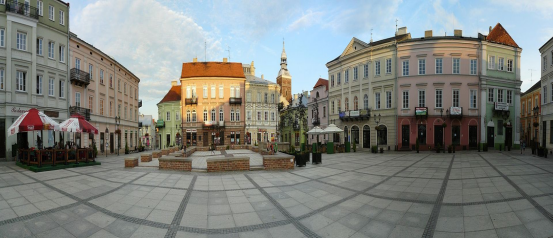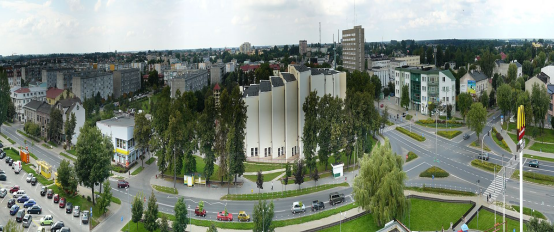Piotrków Trybunalski-Łódź 作者: 来源: 发布时间:2021-05-20
Ⅰ. Population and Area
Population (31 December 2019)
• City 73,090 Decrease (49th)
Area
• City 67.27 km2 (25.97 sq mi)
Website
http://www.piotrkow.pl
Ⅱ.Natural Geography
Piotrków Trybunalski is situated in the middle-west part (Piotrków Plains) of the Łódź Uplands. The population of the city is approximately 80,000 and its area is nearly 68 square kilometres (26 sq mi). The landscape of the Piotrków region and its geological structure was formed during the glaciation of 180,000–128,000 years ago. There are hardly any forests on the Piotrków Plains.
Two rivers cross the region, the Wolbórka and the Luciąża, which with their tributaries flow into the Pilica River and belong to the catchment area of the Vistula River. The watershed of Poland's two main rivers, the Vistula and the Oder (Odra), runs along the meridional line three km west of Piotrków. Two small rivers, the Strawa and the Strawka flow through the city, and it is between their valleys that the first settlement of Piotrków was founded in the early Middle Ages. Recently two more rivers have been included within the boundary of the city area - the Wierzejka, which in the western part of the city forms a reservoir, and the Śrutowy Dołek to the south of Piotrków.
The city is 200 m (656.17 ft) above sea level. The average temperature during the year is about 8 °C (46 °F), the coldest month is January (ranging from −20 to 2.5 °C (−4.0 to 36.5 °F)), the warmest is July (with 18 °C (64 °F) on average). Yearly rainfall is from 550 to 600 mm (22 to 24 in). The sandy soil of the region is not fertile.
Transport
Piotrków lies almost in the centre of Poland. It has a train station on the line from Warsaw to Częstochowa. Direct trains go among others to Cracow, Zakopane, Katowice, Bielsko-Biała, Wrocław, Łódź, Poznań, Szczecin, Świnoujście, Gdynia, Olsztyn and Białystok.
Roads
One expressway and two national roads cross Piotrków:
S8 Kudowa-Zdrój – Budzisko, part of European route E67
- DK 1 Gdańsk – Cieszyn, (planned motorway A1) part of European route E75
- DK 12 Łęknica – Dorohusk
Airports
There is a small airfield for light passenger aircraft in Piotrków. The nearest airport is Łódź Władysław Reymont Airport in Łódź. Two large international airports are Warsaw Frédéric Chopin Airport about 133 km (83 mi) from Piotrków and Katowice International Airport about 137 km (85 mi) from Piotrków.
Ⅲ.Economy
Piotrków Trybunalski is the capital city of the Piotrkowski District. It is the second largest centre of industry, services and culture in the region. The city covers the area of 62.27 km2 and has over 75 thousand inhabitants. The most important advantage of Piotrków is its location in Central Poland, by the A-1 motorway running along the western border of the city. Piotrków is situated on the intersection point of significant national and international roads. Due to the advantageous location and one of the most important Polish railway lines running through the city, Piotrków became an ideal place for investments. In addition to good road and rail connections, the local airport with a 1,000-metre concrete runway for ‘air taxis’ increases the investment attractiveness of the city.
localization PiotrkówConvenient location and excellent road infrastructure and railway attract many investors to Piotrków, making the city one of the most important logistics centres in Poland in recent years.
IKEA Distribution Centre covers the area of 47 ha, 150,000 m2 of which is roofed.
ProLogis Park Piotrków covers the area of 30 ha and has 4 halls of total area of 100,000 m2. Prologis Park Piotrków II – an area of 25 ha, 6 halls of total area of 125,000 m2 planned, currently has one hall of 17,000 m2.
‘Kaufland’ Logistics – an area of 27 ha, 120,000 m2 of storage facilities, meat processing plant and a cold store.
Major projects underway in Piotrków and its immediate neighbourhood:
Logistic City Piotrków Distribution Center – an area of over 100 ha, 4 halls of total area of 136,000 m2 so far, planned roofed area of over 450,000 m2.
P3 Park Piotrków – located within Gmina Grabica (about 7 km from Piotrków), with an area of 122 ha, 2 halls of total area of 75,000 m2 so far, the target storage area of over 500,000 m2.
SPECIAL ECONOMIC ZONE
Business entities operating within the Lodz Special Economic Zone benefit from state aid in a form of exemption from corporate or personal income tax.
State aid is awarded for new investments or job creation
LEVEL OF STATE AID
55% for small enterprises
45% for medium-sized enterprises
35% for large enterprises
Zone investors:
Haering – world leader of machining, manufactures rolling elements for such world concerns as: Bosch, Siemens. The plant in Piotrków is considered one of the best precision lathe plants in the world.
Within the Piotrków subzone also operate: ‘Feniks 2’ Glasssworks Reculer and "Anewal" Glassworks.
Entrepreneurs operating within the Łódź Special Economic Zone benefit from public aid in the form of exemption from corporate or individual income tax. This public aid is granted for new investments and/or creation of new jobs.
Ⅳ.Industrial Characteristics
Piotrków Trybunalski, city, Łodzkie województwo (province), central Poland. It is a manufacturing centre containing textile (principally cotton) mills, woodworks, and glassworks and lies on the Warsaw-Katowice rail line.
Piotrków, thanks to its location, is known as the second largest "logistic centre" after Warsaw. There is a high concentration of warehouses and distribution centres around the city. The biggest distribution centres are:
Prologis Park Piotrkow I and Prologis Park Piotrkow II owned by ProLogis
IKEA Distribution Centre owned by IKEA
Logistic City – Piotrków Distribution Centre owned by local concern Emerson
Poland Central
Focus Mall shopping center.
In Piotrków are also located:
Emerson Polska – self-copying computer paper
Häring – facility producing fuel injection equipment (for Mercedes-Benz, Bosch, Volkswagen)
Metzeler Automotive Profile Systems – car profiles
Kiper brewery
FMG Pioma S.A. – mining machinery, conveyor belts
Sigmatex Sp. z o.o. – knitted fabrics
and many small and medium textile processing factories.
Key Project
1.‘New Old Town’ Project
The project includes comprehensive revitalisation of the streets Zamkowa, Garncarska, Zamurowa and Pereca along with the Podzamcze area through constructing residential and commercial services premises, arrangement of space (boulevards along the river Strawa, greenery, small architecture) and modernisation of municipal infrastructure and streets.
Podzamcze land development aims to create a new residential and service district of Piotrków, attractive for residents, tourists and business.
Piotrków Trybunalski - Oficjalny portal miejski | Economy and investments https://www.piotrkow.pl/en/economy-and-investments-t270
2. Library to be built in Piotrków
The town authorities has appointed Mostostal Warszawa as general contractor. The 6,800 sqm building will include a reading room, and a second-hand bookstore as well as a café above the library. “Under the contract that has been signed Mostostal Warszawa is to build a two-storey building that in its shape will resemble books placed on shelf,” said Dariusz Jarek, the director of general construction at Mostostal Warszawa. The centre will include an underground car park with 50 parking spaces and additional spaces for five motorcycles. The underground section will also include additional storage space. The completion of the work is planned for September 2018.
Library to be built in Piotrków | EurobuildCEE https://eurobuildcee.com/en/news/22601-library-to-be-built-in-piotrkow
Ⅴ.Attrations and Cityscape

Town Square in Piotrków Trybunalski

Market Square on Old Town panorama

Panoramic photo of northern part of Piotrków.
Piotrkow Trybunalski is a listed town. Sightseeing enthusiasts should visit especially: the Old Town, town walls from the 14th and 15th centuries, the royal castle from the early 14th century, the Great Synagogue (1791-1793), i.e. the present Public Library, the Small Synagogue as well as the Jaxa-Bykowskis’ palace from the 15th century. Worth visiting are also sacral monuments, like the All Saints’ Orthodox Church from the 19th century, St. Jacob Church from the 13th century, the Visitation Church from the 14th century as well as Saint Hyacinth and Dorothy Church (the 14th-17th century).
The monuments of Piotrkow and the neighbouring towns and villages may be also seen on the 122-km-long Recreational Trail of the Pilica. Its route is the following: Piotrkow Trybunalski – Barkowice – Bronislawow – Swolszewice – Borki – dike on the Pilica – Smardzewice – Tresta – Zarzecin – Sulejow – Taraska – Szarbsko – Dabrowka – Diabla Gora – Waclawow – Skotniki – Faliszew – Taras – Przedborz – Bialy Brzeg – the neighbourhood of Raczka – Krzetow.
Piotrkow Trybunalski is also worth visiting during its cyclical events. The most interesting of them are: Piotrkow Days (first weekend in June), Cabaret Tribunals festival (Polish: Trybunały Kabaretowe), Critical Mass (each last Friday of a month at 6 pm from Jan Kochanowski University), Chamber Music Days, All-Polish literary contest and Folk Band Festival.
Ⅵ.History and Culture
Piotrków – a royal city
Since the 13th century the city held knights reunions, general reunions of Polish nobility, the clergy synods, parliamentary debates and sessions of the Crown Tribunal – the first European Supreme Court in the Old Republic (1578-1793).
In Piotrków the descendants of Władysław Jagiełło started their reigns (they were chosen in royal elections). In 1404 Jagiełło himself confirmed the old privileges granted to the city. Here the great masters of the Teutonic Order paid their first homage to the rulers of Poland. Here, in 1493, Polish parliamentarism and democracy were born. At that time Piotrków was the second most important in terms of politics city of the Kingdom of Poland.
churchRoute of Many Cultures
An excellent symbol of Piotrków’s multiculturalism is the figure of John Charles Samuel Hildebrandt. Born on 22nd June 1761 in Wartenberg in Brandenburg, he was the first doctor with a degree (he studied medicine and surgery at the universities in Berlin and Frankfurt) in the 18th century Piotrków and the only one in the former Sieradz Voivodeship. He was “His Majesty’s doctor” and later, during the reign of the Prussians, a county physician. Living in Piotrków from 1790, he turned out to be a dedicated doctor and philanthropist, sincerely concerned with lives, health and safety of the poor. According to numerous accounts, he offered help for people in need treating them for free, paying for their medicines, giving alms and supporting them. During the typhus epidemic he published his own instructions promoting easy ways of overcoming diseases and epidemics in “Gazeta Warszawska’ (No.21, 23 in 1813). Moreover, he personally visited patients in local towns and villages disregarding of the risk of infection.
John Hildebrandt repeatedly emphasized and proved his affection to Poland as his chosen homeland. His children grew up in the spirit of being Polish: daughters found Polish husbands and three sons served under Polish banners.
The only thing that remained of that great, honourable man is a unique gravestone donated by the Jews for a German doctor belonging to Evangelical church and buried on a Catholic cemetery.
monasteryThe whole Route of Many Cultures is an area where tradition intermingles with the present. One of the local legends says that Piotrków owes its origins to Czech settlers who, in the end of the 13th century, came to the city and build the Old Town with its narrow streets. However, historical sources do not mention those settlers.
The first foreign nation that settled in Piotrków permanently were the Jews. They are mentioned in Sigismund II Augustus’s privilege from 1569. Another ethnic and religious group that came to Piotrków were orthodox Greeks from Macedonia – fugitives of Ottoman empire admitted to our country in mid-18th century. The third group were the Protestants of German origins. They came to Piotrków in large numbers after 1793 when the city came under the reign of King of Prussia and became the seat of new administrative authorities. At that time a lot of officials, merchants and craftsmen – Evangelical-Augsburg Protestants – lived in Piotrków.
The city also became home for other nations, for example the Scottish family of Watsons. One of its members, Alexander Watson, was the city mayor during the Four-Year Sejm. In June 1791 he took the oath of allegiance to the Constitution of May 3. The next mayor was Antoni Vicini from a family of Italian merchants. He held the office for twenty years.
Ⅶ.Other Information
According to tradition, but not confirmed by historical sources, Piotrków was founded by Piotr Włostowic, a powerful 12th century magnate from Silesia. The name of the city comes from the Polish version of the name Peter (Piotr), in a diminutive form (Piotrek, or "Pete"). Trybunalski indicates that tribunal sessions (including the Crown Tribunal) were held in the town. The town has been known in Yiddish as פּעטריקעװ or Petrikev, in German as Petrikau, and in Russian as Петроков or Petrokov
Ⅷ.Contact Information
-MUNICIPAL OFFICE
-Pasaż Rudowskiego 10
-tel.: 44 732-77-01, 0 800 241 251
-www.piotrkow.pl , mail: e-urzad@piotrkow.pl
-Mayor Krzysztof Chojniak
